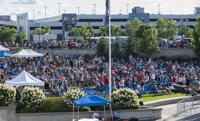DOWN TO BUSINESS – Last month was a tough one for big-name retailers in the Los Angeles area.
Mall stores operated by Yves Saint Laurent, Nordstrom and Macy’s all saw so-called smash-and-grab robberies in which dozens of masked individuals brazenly entered in broad daylight, grabbed what they could, and exited quickly. YSL and Nordstrom each put the losses at $300,000 in high-end purses, clothing and other merchandise. The “flash-rob” sprees are not new, but lately seem to pile one atop the other. Some point a finger at changes tied to the COVID-19 pandemic (who looks twice when a masked shopper enters a store?), while others see a longer time horizon.
Either way, organized retail crime — planned, coordinated robberies, as opposed to ordinary shoplifting — costs retailers close to $100 billion annually, according to industry estimates.
Soon after the incident at the Nordstrom store in suburban LA — with “ransacked” used by police to describe what had occurred — CEO Erik Nordstrom fielded a question about it during the company’s late-August second-quarter conference call.
“Certainly, what happened in our Topanga store is disturbing to all of us,” he said. “Losses from theft are at historical highs, and I’d say we find it unacceptable and [it] needs to be addressed.”
The company is doing that by “looking at everything we can do to make our stores safe and secure,” he said, but added that partnering with local law enforcement is also necessary.
Los Angeles quickly convened a regional multi-agency law enforcement task force to respond to the rash of smash-and-grabs, and by last week had announced more than a dozen arrests.
The Retail Industry Leaders Association, a trade group for major retailers, sees the robberies as having “profound societal implications” beyond bottom-line business impacts. “It poses a safety risk to frontline retail workers, threatens jobs, and diminishes the vibrancy of local communities,” the group says.
The association got behind federal efforts to hold online platforms responsible for policing their sites for counterfeit and stolen products — like those from smash-and-grabs — that took effect in June. It also continues to push for a federal organized retail crime task force that would bring together the Department of Justice, Department of Homeland Security, FBI and the U.S. Postal Service to find and prosecute theft rings.
Meantime, states and regions are forming their own task forces, according to a list compiled by Loss Prevention Magazine. New York soon may get one, too.
Legislation passed the Senate and Assembly in June to create a 15-member task force that would survey current laws and make recommendations on combating the thefts.
“In order to address this complex problem, it is necessary to formalize collaboration among all stakeholders — law enforcement, prosecutors, retailers and retail employee advocates,” reads the bill memo.
Bill-tracking sites indicate the legislation has not yet been sent to Gov. Kathy Hochul for action.
Marlene Kennedy is a freelance columnist. Opinions expressed in her column are her own and not necessarily the newspaper’s. Reach her at marlenejkennedy@gmail.com.







